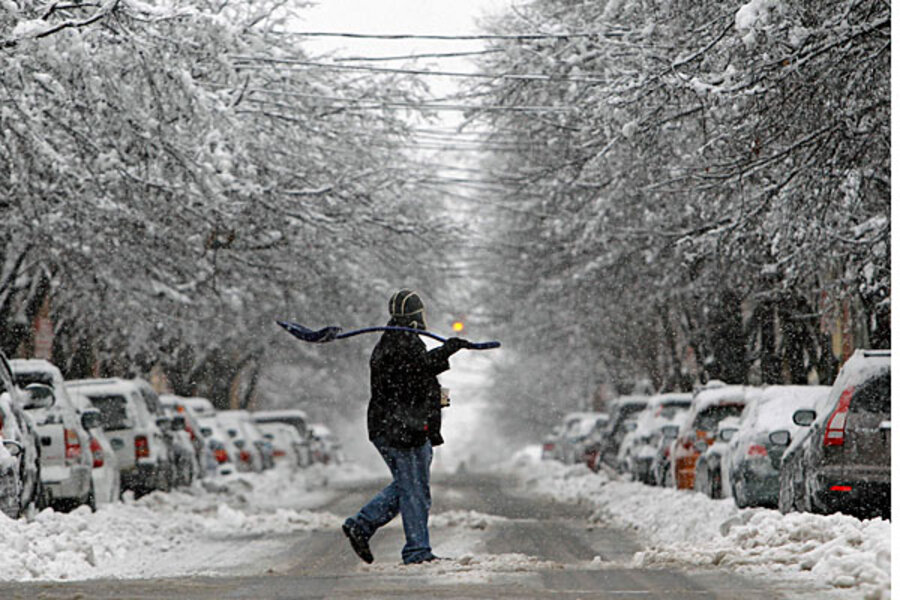Winter forecast: La Niña returns, southern drought persists
Loading...
Last winter, with its droughts, tornado outbreaks, heavy snows, and floods was a tough one in different ways for millions of people.
Be prepared for more of the same this winter and into early spring, say forecasters with the National Oceanic and Atmospheric Administration.
The agency's seasonal outlook for the coming winter calls for cooler-than-normal temperatures up and down the West Coast and across the northern tier from the Pacific Northwest through the Great Lakes Region. The southern tier is expected to see warmer-than-normal temperatures from the eastern half of Arizona though western Mississippi.
More challenging for the already parched southern tier is the precipitation outlook. From southern California to the southern Great Plains and into the Southeast US, the southern half of the country is expected to be drier than normal, which would reinforce an already devastating drought centered on Texas and into New Mexico, Oklahoma, and spilling into neighboring states.
Ninety-one percent of Texas, 87 percent of Oklahoma, and 63 percent of New Mexico are experiencing either extreme or exceptional drought conditions – the designations given the two most-severe rankings, according to David Brown, climate services director at the National Weather Service's southern regional headquarters in Ft. Worth, Texas.
For the 12-month period ending Sept. 30, sections of southeast Texas saw rainfall totals up to 30 inches below normal, he says. The water level in Lake Travis, a popular recreation spot northwest of Austin, is 30 feet below normal.
Along with the exceptional drought and high temperatures throughout the summer texas lost more than 3.5 million acres to wildfires this year.
"It would take upwards of 10 or 15 inches of rain in many areas to make an appreciable improvement in the drought situation," he says. Given the outlook for this winter, "the likelihood of seeing that kind of relief here in the southern plains is pretty low."
Forecasters attribute the general trends expected for temperatures and precipitation to La Niña, one half of a cyclical shift in sea temperatures and atmospheric pressure across the tropical Pacific. El Niño forms the other half.
Under La Niña conditions, warm surface waters in the tropical Pacific migrate west, allowing cold water from deep in the eastern Pacific to reach the surface along the west coast of Central and South America and fill in behind the departing warm water. The migration of warm water back and forth across the tropical Pacific every few years alters atmospheric circulation patterns in ways that can have effects far beyond the topics.
In winter La Niña tends to drive average storm tracks across the US farther north than usual, drying out the southern US while dumping snow on the Pacific Northwest, the northern Rockies, and points east.
La Niña was a major player last year, and it's back this winter, although weaker. Forecasters pegged last year's La Niña as moderate-to-strong. This winter, they expect a weak-to-moderate event.
Although La Niña sets the tone for winter weather patterns, especially in the southern US, it isn't the only player. A feature known as the Arctic Oscillation (AO), which has its own rhythms, can reinforce or undercut La Niña's effects, forecasters say.
The AO shows up as the strengthening or weakening of a fast-moving river of air – the polar jet stream – that circles the globe at high latitudes. When the AO is weak, outbreaks of frigid Arctic air can reach deep into the southern US and beyond.
"Last winter, the Arctic Oscillation played a large role, but mainly from December to the middle of January," says Mike Halpert, deputy director of NOAA's Climate Prediction Center in Camp Springs, Md. It was weak through that period, bringing unusually cold temperatures to the southern US.
After mid January, the oscillation shifted into its positive phase and kept the cold air up north, returning temperature patterns north to south more in line with a typical La Niña event.
The Arctic Oscillation "really is a wild card" as forecasters try to pull together their seasonal outlook for winter, says Mr. Halpert.
At this point, forecasters can only provide their best estimate of its future behavior a week or two in advance, he adds.
Even as warm and dry conditions have persisted in the south, conditions in the northern Plains are setting the stage for an increased risk of severe floods with next spring's snowmelt, according to forecasters at NOAA's Hydrometeorological Prediction Center in Camp Springs.
Noting that the Missouri River basin experienced extensive flooding this year, leaving soil moisture and river levels fairly high, if the region has an above-normal snowfall this winter, as projected, during spring melt "the ingredients are there" for significant flooding, says Robert Kelly, who heads the center's forecast-operations branch.





